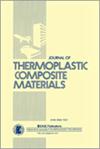Improving film adhesive joining performance of poly(phenylene sulfide)/carbon fiber thermoplastic composite laminates by plasma surface treatment
IF 3.6
4区 材料科学
Q2 MATERIALS SCIENCE, COMPOSITES
引用次数: 0
Abstract
The main purpose of this study was to observe the degree of the improvement on the film adhesive joining performance of Poly(phenylene sulfide)/Carbon Fiber (PPS/CF) thermoplastic composite laminates when their surfaces were treated by atmospheric plasma technique. For this purpose, plasma treated surfaces were compared with untreated and the traditional grit-blasted surfaces. Treated surfaces were characterized by various techniques including contact angle, surface energy, surface roughness, Fourier transform infrared spectroscopy (FTIR) and X-ray photoelectron spectroscopy (XPS) analyses. Then, joining performance of the PPS/CF composite samples bonded by an epoxy-based film adhesive was determined by using three different mechanical tests; single-lap shear strength, mode-I interlaminar fracture toughness energy, and drop-weight impact toughness. Grit-blasting surface treatment increased surface roughness of the specimens enormously (7 times more), leading to mechanical interlocking as the dominant bonding mechanism. Contrarily, plasma surface treatment resulted in formation of chemically reactive sites, thus dominant bonding mechanisms in the film adhesive joining were certain polar interactions and chemical bonding. Mechanical tests pointed out that compared to grit-blasting, plasma surface treatment resulted in considerably higher joint performance regarding interlaminar shear strength (35% more), interlaminar fracture toughness (67% more) and impact toughness (28% more), with the cohesive failure mode. Accordingly, it could be stated that traditional grit-blasting could be replaced with plasma surface treatment applied before film adhesive joining of PPS/CF composite parts in aircraft industry.等离子体表面处理提高聚苯硫醚/碳纤维热塑性复合材料层合板的粘接性能
本研究的主要目的是观察采用常压等离子体技术对聚苯硫醚/碳纤维(PPS/CF)热塑性复合材料层合板进行表面处理后,其薄膜粘接性能的改善程度。为此,将等离子体处理表面与未处理表面和传统喷砂表面进行了比较。利用接触角、表面能、表面粗糙度、傅里叶变换红外光谱(FTIR)和x射线光电子能谱(XPS)等多种技术对处理后的表面进行了表征。然后,通过三种不同的力学试验,确定了环氧基薄膜胶粘剂粘接PPS/CF复合材料样品的连接性能;单圈剪切强度、i型层间断裂韧性能、落锤冲击韧性。喷砂表面处理大大提高了试样的表面粗糙度(提高了7倍),导致机械联锁成为主要的结合机制。相反,等离子体表面处理导致了化学反应位点的形成,因此在膜胶粘剂连接中主要的键合机制是一定的极性相互作用和化学键合。力学试验表明,与喷砂相比,等离子体表面处理可显著提高节理的层间剪切强度(提高35%)、层间断裂韧性(提高67%)和冲击韧性(提高28%),并具有内聚破坏模式。因此,在飞机工业中,PPS/CF复合材料零件的膜粘接前,可以采用等离子体表面处理取代传统的喷砂处理。
本文章由计算机程序翻译,如有差异,请以英文原文为准。
求助全文
约1分钟内获得全文
求助全文
来源期刊

Journal of Thermoplastic Composite Materials
工程技术-材料科学:复合
CiteScore
8.00
自引率
18.20%
发文量
104
审稿时长
5.9 months
期刊介绍:
The Journal of Thermoplastic Composite Materials is a fully peer-reviewed international journal that publishes original research and review articles on polymers, nanocomposites, and particulate-, discontinuous-, and continuous-fiber-reinforced materials in the areas of processing, materials science, mechanics, durability, design, non destructive evaluation and manufacturing science. This journal is a member of the Committee on Publication Ethics (COPE).
 求助内容:
求助内容: 应助结果提醒方式:
应助结果提醒方式:


